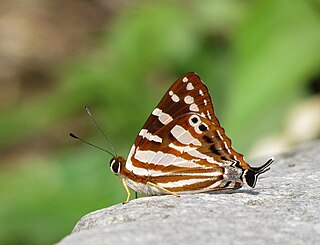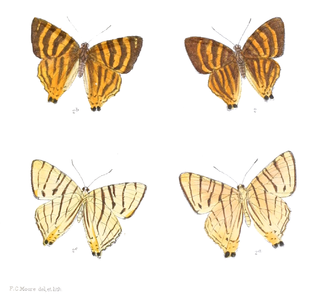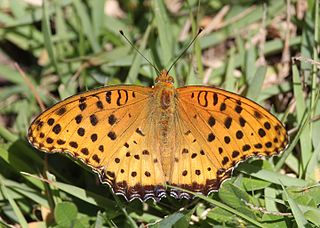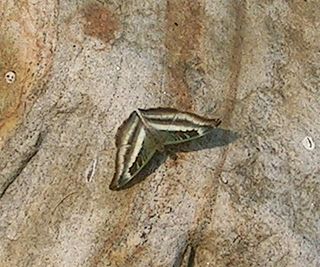
Papilio paris, the Paris peacock, is a species of swallowtail butterfly found in the Indian subcontinent and southeast Asia.

Papilio castor, the common raven, is a species of swallowtail butterfly found in Cambodia and South Asia.

Meandrusa sciron, the brown gorgon, is a species of swallowtail butterfly found in parts of South Asia and Southeast Asia. It belongs to the hooked swallowtails genus, Meandrusa, of the family Papilionidae. The brown gorgon is found in India from Sikkim to Assam and north Burma and is not considered to be threatened. Though not uncommon, it is protected under Indian law under the name gyas.

Meandrusa payeni, the yellow gorgon, is a species of swallowtail found in parts of South Asia and Southeast Asia. It belongs to the hooked swallowtails genus, Meandrusa, of the family Papilionidae. It is also called the outlet sword or the sickle.

Dodona egeon, the orange Punch, is a small but striking butterfly found in the Indomalayan realm - in Mussoorie to Assam, Burma (nominate) and Peninsular Malaya that belongs to the family Riodinidae.

Dodona adonira, the striped Punch, is a small but striking butterfly found in the Indomalayan realm that belongs to the Punches and Judies, that is, the family Riodinidae.

Delias hyparete, the painted Jezebel, is a medium-sized butterfly of the family Pieridae, found in South Asia and Southeast Asia.

Charaxes marmax, the yellow rajah, is a butterfly found in India that belongs to the rajahs and nawabs group, that is, the Charaxinae group of the brush-footed butterflies family.

Castalius rosimon, the common Pierrot, is a small butterfly found in India that belongs to the lycaenids, or blues family.

Azanus ubaldus, the bright babul blue, desert babul blue, or velvet-spotted blue, is a small butterfly found in India, the Middle East and Africa that belongs to the lycaenids or blues family.

Azanus jesous, the African babul blue or topaz-spotted blue, is a small butterfly found in Africa, Egypt, Syria, India, Sri Lanka and Myanmar that belongs to the lycaenids or blues family.

Hypolimnas misippus, the Danaid eggfly, mimic, or diadem, is a widespread species of nymphalid butterfly. It is well known for polymorphism and mimicry. Males are blackish with distinctive white spots that are fringed in blue. Females are in multiple forms that include male-like forms while others closely resemble the toxic butterflies Danaus chrysippus and Danaus plexippus.

Lycaenopsis marginata, the margined hedge blue, is a small butterfly found in India that belongs to the lycaenids or blues family.

Hypermnestra helios is a species of swallowtail butterfly belonging to the Parnassinae family and is the sole member of the genus Hypermnestra. It is found in Iran, Afghanistan, Pakistan, Turkmenistan, Kirghizstan, Tajikistan, and Uzbekistan. It is locally common in desert habitats.

Cethosia nietneri, the Tamil lacewing, is a species of nymphalid butterfly found in Sri Lanka and south India. The species name is after John Nietner who obtained specimens of the butterfly from Ceylon from which it was described.

Vindula erota, the common cruiser, is a species of nymphalid butterfly found in forested areas of tropical South Asia and Southeast Asia.

The Indian fritillary is a species of butterfly of the nymphalid or brush-footed family. It is usually found from south and southeast Asia to Australia.

Vagrans is monotypic genus with the species vagrant a species of nymphalid butterfly found in forested areas of tropical South Asia and Southeast Asia.

Catochrysops strabo, the forget-me-not, is a small butterfly found in Asia that belongs to the lycaenids or blues family. The species was first described by Johan Christian Fabricius in 1793. It is found in Sri Lanka, India, from Sikkim to Indochina and in Sundaland, Sulawesi and the Philippines.

Auzakia is a monotypic butterfly genus in the family Nymphalidae. It contains the single species, Auzakia danava, the commodore, which is found from Tibet to Sumatra.






















